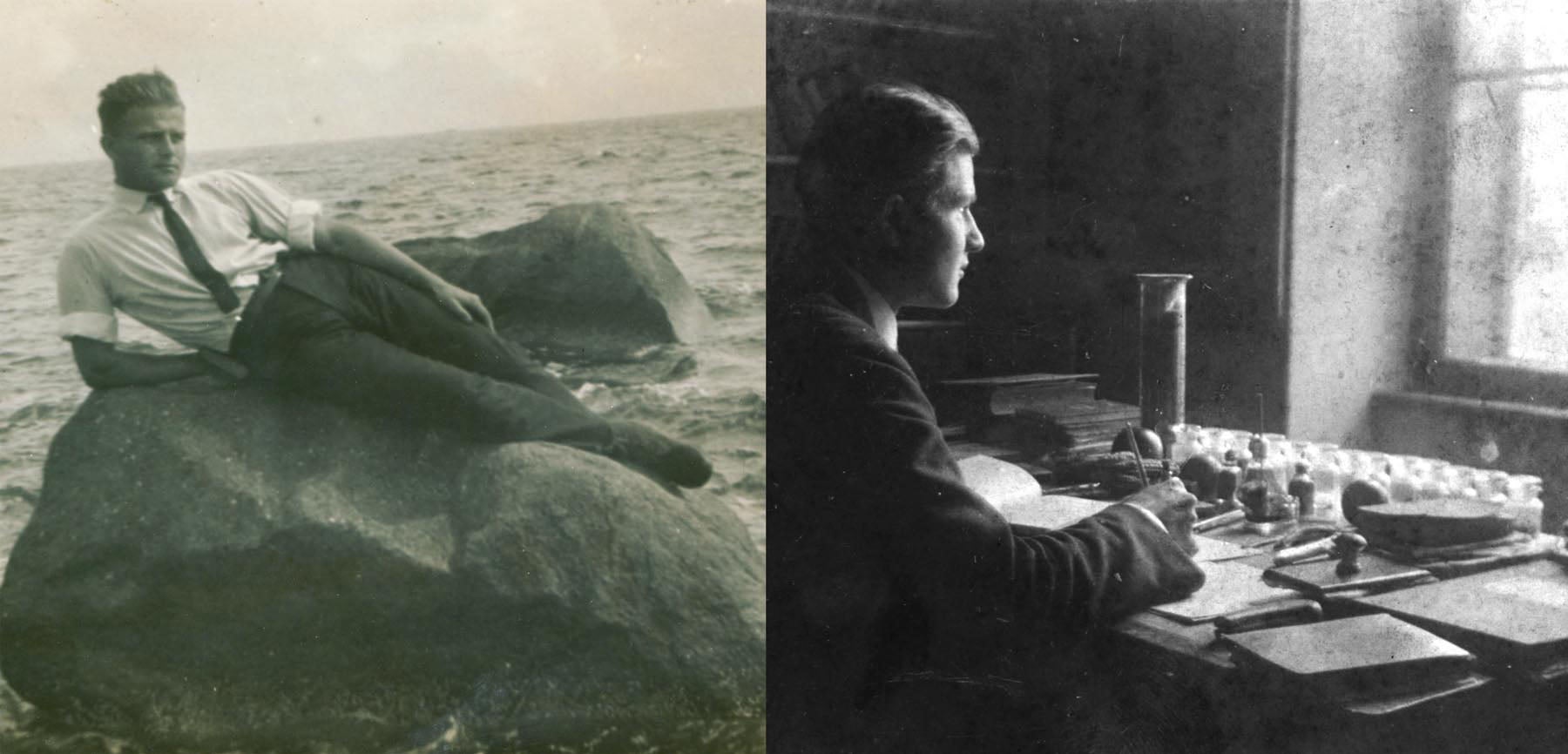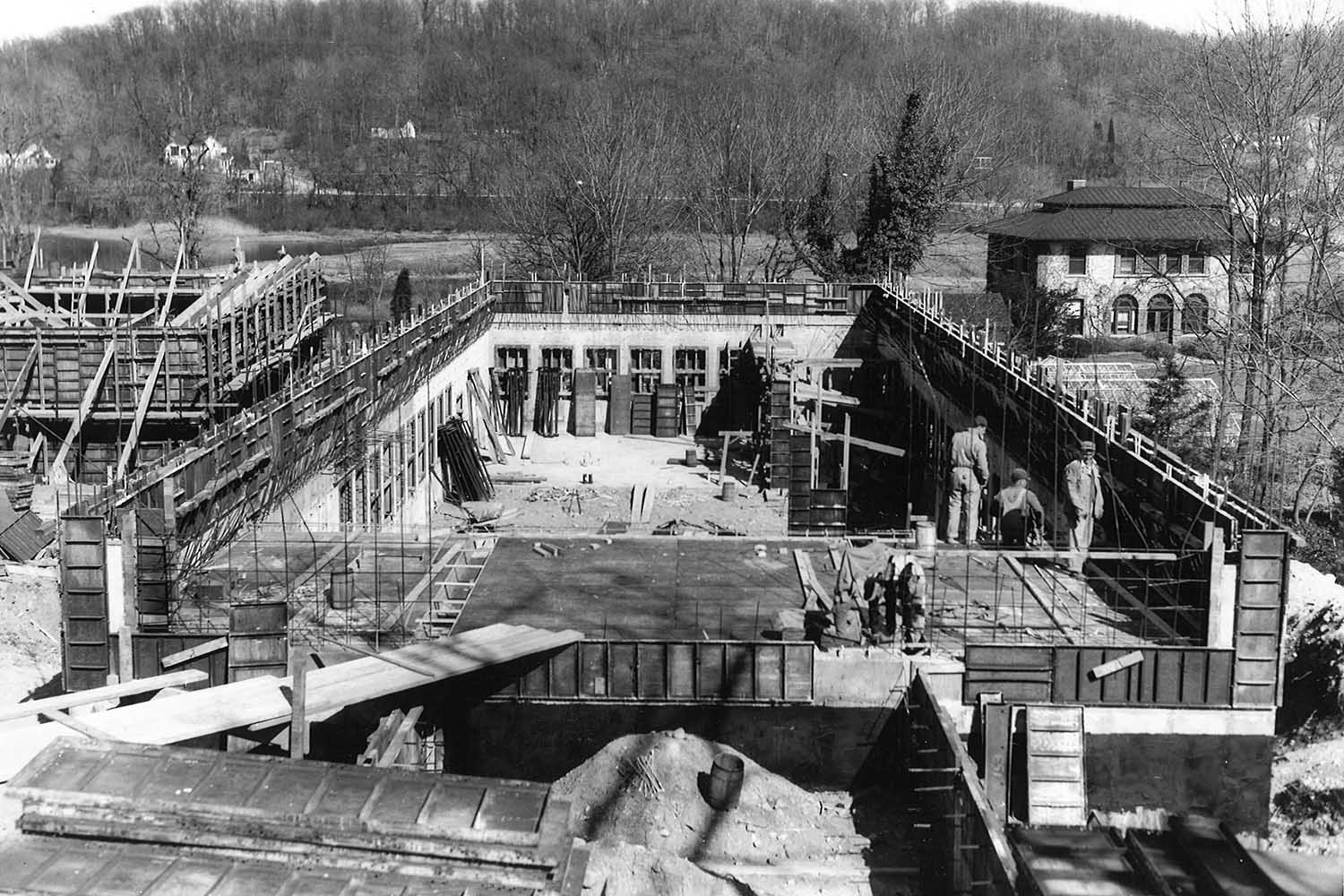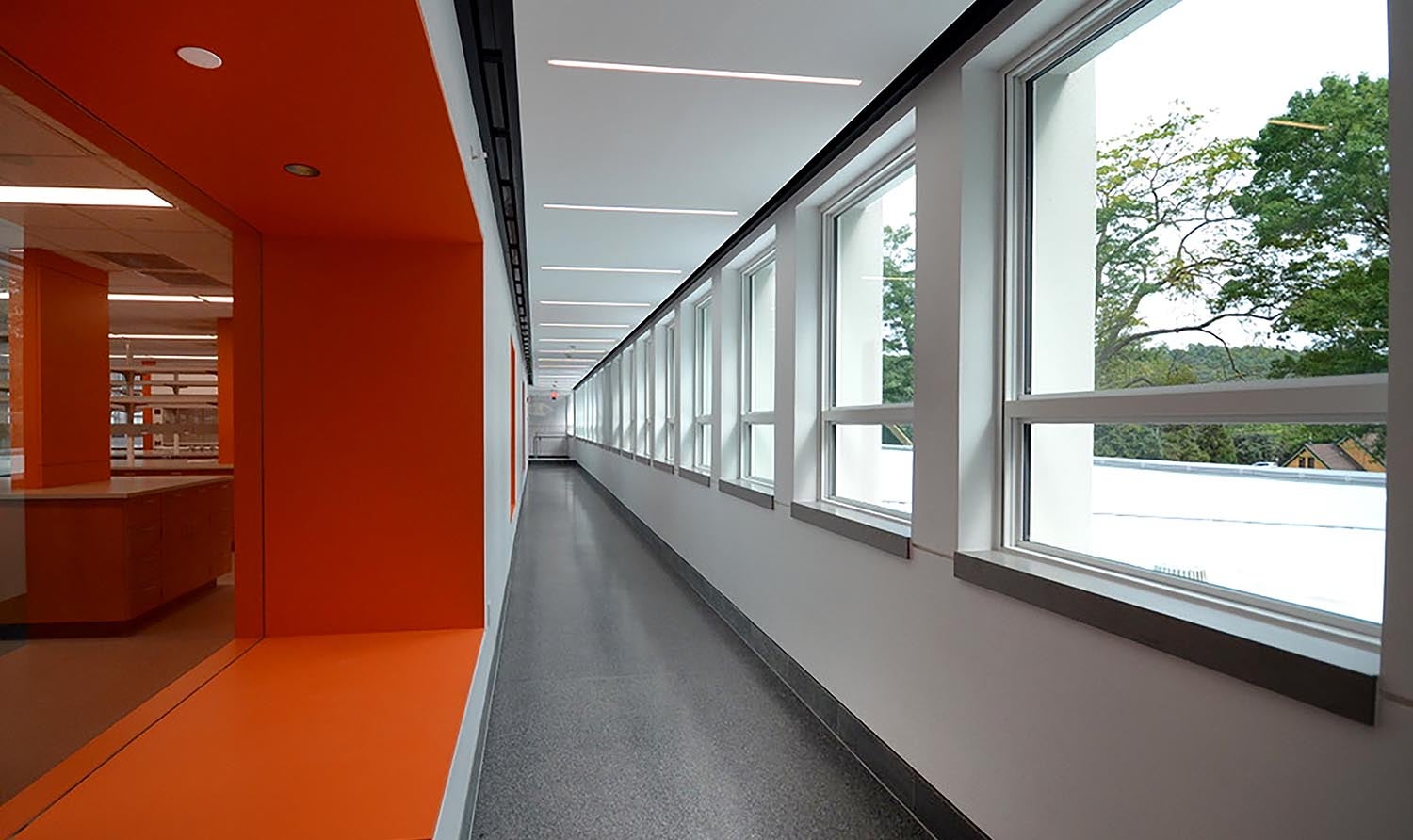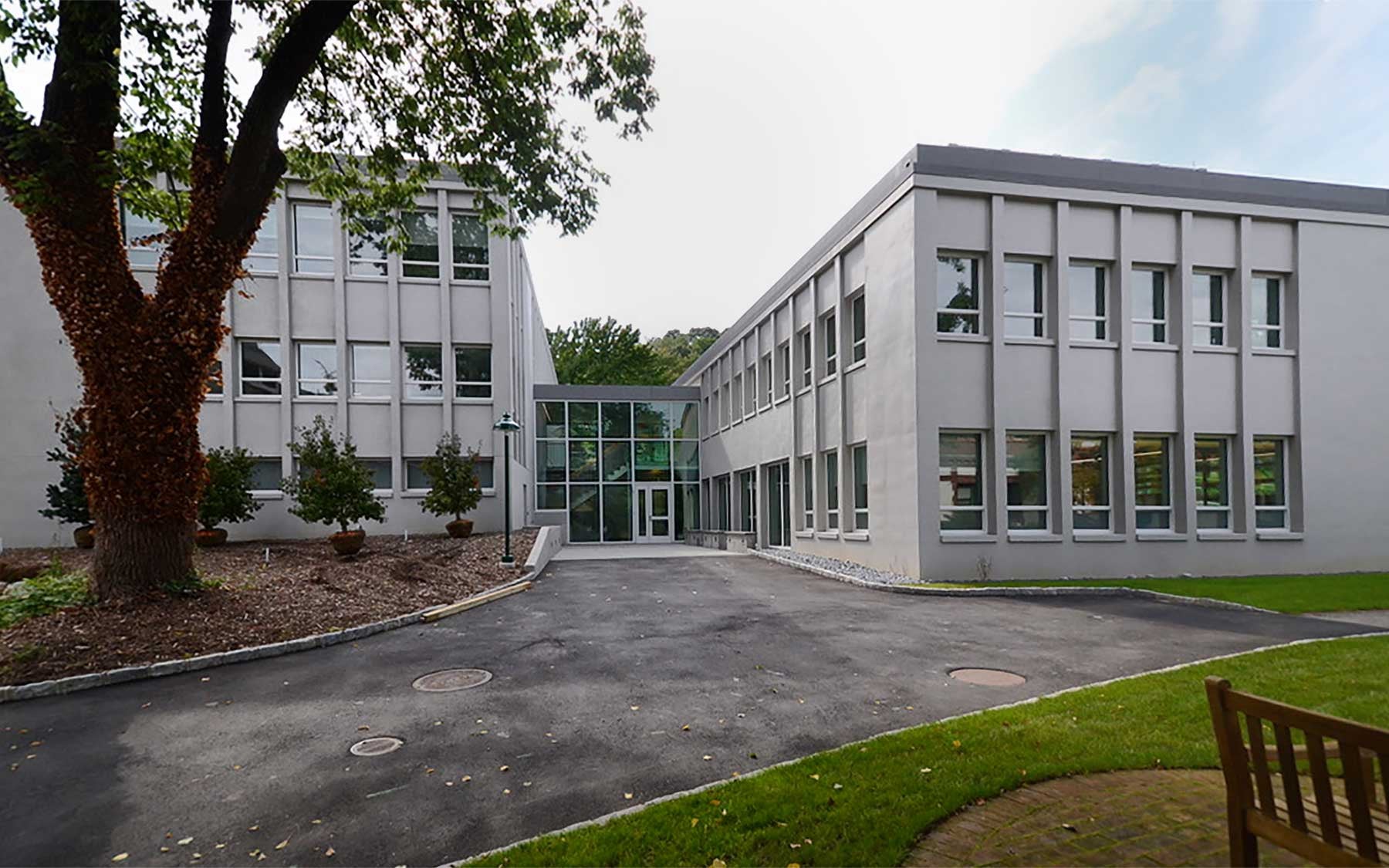Cold Spring Harbor Laboratory (CSHL) is unique among cutting-edge research campuses. Along the waterside, you’ll find quaint cottages looking unchanged from their nineteenth-century whaling town origins. Deeper into these grounds, cottages are eclipsed by the red brick facades and sweeping arches that housed some of science’s first forays into genetics in the early 1900s. Deeper still, brick gives way to glass and steel and booming auditoriums where scientific leaders discuss breakthroughs in cancer treatments, gene editing, neuroscience, and plant and quantitative biology.
Walking the campus is a history lesson spelled out with walls, doors, and roof tiles. But one unassuming building marks an entire chapter.
Built in 1953 to mark a new era for Cold Spring Harbor’s ‘scientific village,’ the unabashedly bare concrete walls of the Demerec building have seen the groundbreaking work of leading researchers, including four Nobel laureates. Now, after a $75-million makeover of this historic structure, the Laboratory is about to pursue a new direction for fundamental biology and cancer treatment research.
The man and the building
Even on a scientific campus as architecturally eclectic as CSHL, the two-story, 16,000-square-foot rectangular building, with its flat roof and cement exterior, is the only lab space of its kind.
Structures such as the Demerec building are called “brutalist” and are known for their relatively low construction cost and no-nonsense use of space. Forgoing adornment, brutalist buildings celebrate their shrewd, “waste not” design by letting the primary material (usually cement slabs or concrete bricks) stay bare.
Choosing efficiency over frivolity describes more than just the Demerec building. Milislav Demerec, the lab’s namesake, was also a no-nonsense figure whose pursuit of only the best subjects of study was an important first step in the Lab’s ascension as a scientific leader.
In the early 1900s, genetics was in its infancy. Because the field was so new, geneticists often abandoned half-baked research goals to pursue popular new ones. It was a time of big ideas and frequent failure. But for a young Milislav Demerec, there was a better path towards scientific success. He was determined to use the best materials possible to efficiently reach his goal.

That goal was characteristically unflashy. He aimed to map the portions of a genome that are prone to mutation. After studying genetic variation in maize (corn) at Cornell University, Demerec joined the Carnegie Institution of Washington’s Department of Genetics1 in 1924. Housed on the Cold Spring Harbor campus on Long Island, New York, it was an idyllic location for Demerec to turn his attention to the Larkspur flower (Delphinium). Despite having trained under the early maize geneticist Rollins Emerson, young Demerec suspected that Delphinium was going to be a better subject for studying mutations. Shortly after coming to Cold Spring Harbor, the budding geneticist had already identified six unstable portions of the flower’s genome.
Many burgeoning scientists might have stopped here and committed to studying the new, exciting subject of their choice. But for Demerec, this was an inflection point. Delphinium was slow-breeding, so in the interest of time efficiency, he stepped away from studying plants entirely. He needed an organism with a short but highly prolific life.2
Enter, Drosophila virilis. This is a type of fruit fly that can be found worldwide, lives for only a couple of months, and is a strong reproducer. Adult female Drosophila lay hundreds of eggs in a single clutch, making them the ideal material from which to tease out the secrets of mutation. By the end of the 1920s, other geneticists realized just how optimal fruit flies were for studying genes. Drosophila dominated the world of genetics. As a pioneer, Demerec was at the center of it. He published more than a dozen papers about fruit fly mutations within the following decade and organized experts from other corners of the U.S. to compile a Drosophila Information Service newsletter offering guidelines for studying fruit flies. In this way, Demerec became a leading voice for countless fledgling geneticists.
“He and his work had established Cold Spring Harbor as a leader,” science historian Jan Witkowski wrote in his book, “The Road to Discovery,” a history of CSHL.
Demerec’s dogged pursuit of optimal materials and efficient science led to his promotion to Director at the Cold Spring Harbor campus in 1941. But, true to form, Demerec would soon turn his attention to yet another subject that emerged during the early days of World War II.
Penicillin, used to fight infections, was a life-saver on the front lines. As the war pressed on, it was in dangerously short supply. Demerec, an expert in how X-rays induce mutations in fruit flies, used his techniques for inducing genetic mutations on Penicillium mold. Before this, mold cultures could only produce enough penicillin to treat 10 people per batch. But after Demerec’s research revealed how radiation exposure could alter the genes that limited the mold’s reproduction, penicillin yields skyrocketed. The antibiotic was ready for mass production.
Watch how Milislav Demerec boosted penicillin production.
After the war: More victories
War is costly, and in the post-war years, little funding was spared for basic biological research.
“Our expectations that the end of the war would allow us to return to a state bordering on normalcy have unfortunately not been fulfilled,” Demerec wrote in the Lab’s 1945 Annual Report.
Characteristic of Demerec’s own no-nonsense approach to science, the director set out to clarify the Cold Spring Harbor campus’ research goals, emphasizing ones that could elicit government and private funding. With the aid of Barbara McClintock, a rising scientific star who focused on cytogenetics, Demerec wrote a letter appealing to the Carnegie Institution of Washington to fund a new Department of Genetics on the campus. The department, they wrote, would “anticipate, as best we can, the paths that will lead to the most enlightening contributions” in gene science.
While waiting for a response from the Lab’s sponsors in Washington D.C., Demerec displayed his penchant for shrewd efficiency once more—this time through careful budgeting and housekeeping. Over the next several years, residents of the Laboratory would catch Demerec wandering the campus late at night, turning the lights off in unused buildings to cut electricity costs.
Finally, in 1951, a laboratory to house the new Department of Genetics began to take shape.

It took three years to complete. In contrast to the harborside homes on the campus, the new lab was designed from the ground up as a research facility.
“Demerec has been a remarkable building—arguably probably one of the most productive buildings in all of science,” said CSHL President Bruce Stillman, who first started researching the secrets of DNA replication within Demerec’s walls in 1979. “Since it was built, four scientists have done work in that building that led to their receiving their Nobel Prize.”
These Nobelists include Barbara McClintock, whose discovery of “jumping genes” changed genetics forever. Alfred Hershey and Martha Chase likewise, walked Demerec’s halls shortly after its walls were up. The duo proved that DNA, not protein, carries genes, and they accomplished this with no more than a cocktail blender. After the Department of Genetics officially transformed into the independently operated Cold Spring Harbor Laboratory in 1963, scientific leaders including Dr. Carol Greider, Sir Richard Roberts and President Stillman followed in those first trailblazing footsteps. More followed.
You can find out about all the amazing people and discoveries that have graced the Demerec halls in this interactive timeline.
“I was in that building for 12 memorable years,” said Stillman, who first started researching DNA replication at Demerec in 1979. “They were very productive years for our science… I think that building has a mojo about it.”
Defining Demerec’s future
Naturally, Stillman won’t let the modern occupants of Demerec rest on the laurels of their predecessors. With the renovation of the building’s interior wrapping up and new faculty moving in, CSHL is braced to write a new chapter for the historied halls.
“This renovation allows us to really think about where the Lab will take things next,” says Stillman. “We’re adding a new program that addresses the whole-body physiology and the impact cancer has on that.”
What is whole-body physiology? Oftentimes, clinicians may treat the tumor alone, not considering how the rest of a patient’s body may help or hinder treatment. The new program looks to change that and capitalizes on many of CSHL’s long-standing strengths, including a culture of collaboration that bridges various fields of study.
A strong example of this is the work of Semir Beyaz, Ph.D. He studies how nutrition can affect a body’s response to cancer treatments, and he’ll be joining forces with medical doctor-turned-scientist, Tobias Janowitz, M.D., Ph.D. Together, they’ll show why taking whole-body physiology into account may be paramount in a battle against cancer.
“Too often we are not looking at the patient and the system of the patient. And we are not looking even though there are obvious signs that we should be looking,” Janowitz recently told the CSHL Association of community supporters. “We need to start rethinking cancer medicine.”
CSHL President Bruce Stillman explains the importance of the renovated Demerec lab.
The new Demerec building also boasts CSHL leaders such as Nicholas Tonks, a researcher best known for investigating ties between cancer and obesity. Also leading efforts to meet the building’s new research goals is Linda Van Aelst, a neuroscientist who is working to understand how the complex mammalian nervous system can be affected by cancerous cells.
And the approach of connecting basic scientific research with real patients won’t stop with just collaboration between scientists.
“This will result in us reaching out to a lot of different places,” Stillman said. “It’s an evolution in what we’re doing, and it will be facilitated by interactions with partners like Northwell Health.”
In 2015, Cold Spring Harbor Laboratory signed an affiliation agreement with Northwell Health, which is the largest healthcare system in the Northeast of the United States. With 23 hospitals and hundreds of medical groups, Northwell is bringing CSHL-borne innovation to more patients and clinical trials than ever before. Likewise, biopsies voluntarily offered by Northwell patients will bring valuable patient-centric data to the lab bench.
More than a lab
It’s worth mentioning that science in the 1900s and science today are radically different and require radically different lab spaces. The Demerec laboratory needed an upgrade to continue its legacy well into the 21st century. Now, two years of renovation and $75 million later, the legacy continues.
And from the outside, it doesn’t look all that different.
Photo Credits: 1950—CSHL Archives (CC BY-NC) | Today—CSHL Dept. of Public Affairs
“We really challenged ourselves to preserve the history of the building as much as possible,” said architect Todd E. Andrews, who planned the renovation.
Andrews and his colleagues at Centerbrook, an architectural and design firm in Centerbrook, Conn., have been helping CSHL renovate and build new science facilities for the last three decades, and the significance of renovating such a cornerstone for the Laboratory’s research is not lost on him. In a recent blog post, they explained the building’s “full-circle transformation”—abolishing previous renovations in favor of restoring the building’s original facade and outfitting its interior with more space (25,000 square feet) and modern amenities.
“It is important to allow the building to not only be a science lab, but also an acknowledgment of the researchers that have been there, and the accomplishments that they’ve made,” he said.
But pulling this off was no small feat. In order to facilitate the Laboratory’s new goal of whole-body physiology research, scientists in the Demerec laboratory will be working with cells from patients, custom-made molecules, and other potentially hazardous biological materials. Safety for the researchers and environment alike is paramount, and the architects needed to find ways to add modern safety equipment to a building that was already designed to make use of all available space.
“The ductwork is a good example,” Andrews said. “Equipment like the air handler units that are required for modern laboratories were really going to change the tightly-designed dynamic of the building.”
This bulky equipment is traditionally perched on a laboratory’s rooftop, but in order to preserve Demerec’s bare-faced design, the Centerbrook team created an entirely new mechanical room underground. The equipment that keeps the air clean and safe for scientists is cleverly hidden away. “There’s more to the building than meets the eye,” the architect says.

This held true for the building even before Centerbook’s clever additions. It may look like just some unadorned concrete building, but it has always been so much more. “This place is hallowed ground for science,” New York Governor Andrew Cuomo said during the renovation’s 2017 groundbreaking.
New York State contributed $25 million towards the laboratory renovation. Named one of the Empire State’s key “life science incubators”—and reminiscent of Milislav Demerec himself—CSHL’s pursuit of the best scientific strategies will continue making CSHL’s home state a national leader in biology and biotechnology.
“This place provides hope,” added Senator Carl L. Marcellino. “It’s not the cement, or the steel, or the bricks and mortar we’re talking about here, it’s the people—the researchers who work in those laboratories. It is one of the jewels of Long Island.”
1 The story originally stated: “After studying genetic variation in maize (corn) at Cornell University, Demerec joined the Carnegie Institution of Washington’s Station for Experimental Evolution in 1924.”
2 The story originally stated: “For many burgeoning scientists, it would be there that they committed to studying the new and exciting subject of their choice, but for Demerec it was merely another stepping stone. Delphinium was slow-breeding, so in the interest of time efficiency, he stepped away from studying plants entirely. He needed an organism with short but highly prolific lives.”
Written by: Brian Stallard, Content Developer/Communicator | publicaffairs@cshl.edu | 516-367-8455
